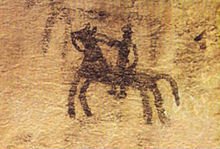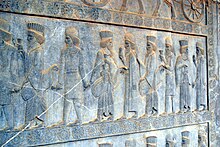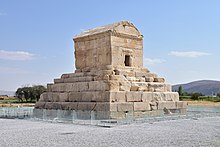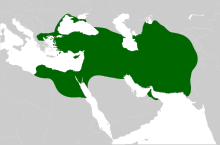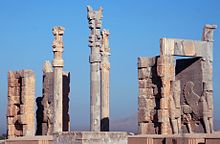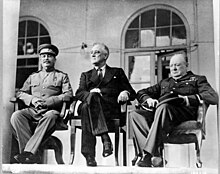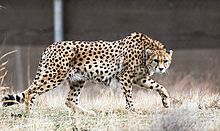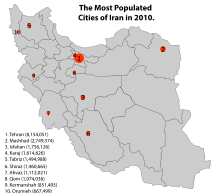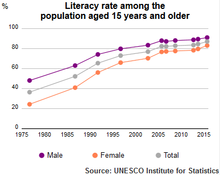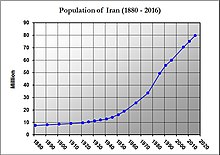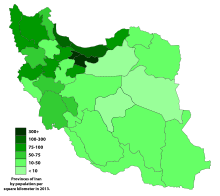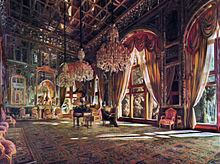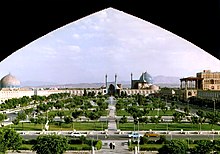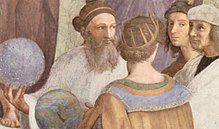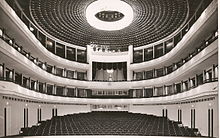Iran
Coordinates: 32°N 53°E / 32°N 53°E
Islamic Republic of Iran جمهوری اسلامی ایران (Persian) Jomhuri-ye Eslāmi-ye Irān | |
|---|---|
Anthem: سرود ملی جمهوری اسلامی ایران Sorud-e Melli-ye Jomhuri-ye Eslāmi-ye Irān ("National Anthem of the Islamic Republic of Iran") | |
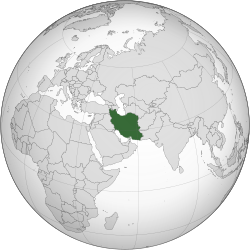 | |
| Capital and largest city | Tehran 35°41′N 51°25′E / 35.683°N 51.417°E |
| Official languages | Persian |
| Recognised regional languages | |
| Ethnic groups | List of ethnicities
|
| Religion |
|
| Demonym(s) |
|
| Government |
|
| Ali Khamenei | |
| Hassan Rouhani | |
| Eshaq Jahangiri | |
| Mohammad Bagher Ghalibaf | |
| Ebrahim Raisi | |
| Legislature | |
| Islamic Consultative Assembly | |
| Establishment history | |
| c. 678 BC | |
| 550 BC | |
| 247 BC | |
| 224 AD[12] | |
| 934 AD | |
| 1501[13] | |
| 15 December 1925 | |
| 7 January 1978 – 11 February 1979 | |
| 24 October 1979 | |
| 28 July 1989 | |
| Area | |
• Total | 1,648,195 km2 (636,372 sq mi) (17th) |
• Water (%) | 7.07 |
| Population | |
• 2019 estimate | 83,183,741[14] (17th) |
• Density | 48/km2 (124.3/sq mi) (162nd) |
| GDP (PPP) | 2019 estimate |
• Total | |
• Per capita | |
| GDP (nominal) | 2019 estimate |
• Total | |
• Per capita | |
| Gini (2016) | medium |
| HDI (2018) | high · 65th |
| Currency | Rial (ریال) (IRR) |
| Time zone | UTC+3:30 (IRST) |
• Summer (DST) | UTC+4:30 (IRDT) |
| Date format | yyyy/mm/dd (SH) |
| Driving side | right |
| Calling code | +98 |
| ISO 3166 code | IR |
| Internet TLD | |
Iran (Persian: ایران Irān [ʔiːˈɾɒːn] (![]() listen)), also called Persia,[18] and officially the Islamic Republic of Iran (Persian: جمهوری اسلامی ایران Jomhuri-ye Eslāmi-ye Irān (
listen)), also called Persia,[18] and officially the Islamic Republic of Iran (Persian: جمهوری اسلامی ایران Jomhuri-ye Eslāmi-ye Irān (![]() listen) [dʒomhuːˌɾije eslɒːˌmije ʔiːˈɾɒn]), is a country in Western Asia.[19][20] It is bordered to the northwest by Armenia and Azerbaijan,[a] to the north by the Caspian Sea, to the northeast by Turkmenistan, to the east by Afghanistan and Pakistan, to the south by the Persian Gulf and the Gulf of Oman, and to the west by Turkey and Iraq. Its central location in Eurasia and proximity to the Strait of Hormuz give it significant geostrategic importance.[21] Tehran is the capital and largest city, as well as the leading economic and cultural hub; it is also the most populous city in Western Asia, with more than 8.8 million residents, and up to 15 million including the metropolitan area.[22] With 83 million inhabitants,[14] Iran is the world's 17th most populous country.[23] Spanning 1,648,195 km2 (636,372 sq mi), it is the second largest country in the Middle East and the 17th largest in the world.
listen) [dʒomhuːˌɾije eslɒːˌmije ʔiːˈɾɒn]), is a country in Western Asia.[19][20] It is bordered to the northwest by Armenia and Azerbaijan,[a] to the north by the Caspian Sea, to the northeast by Turkmenistan, to the east by Afghanistan and Pakistan, to the south by the Persian Gulf and the Gulf of Oman, and to the west by Turkey and Iraq. Its central location in Eurasia and proximity to the Strait of Hormuz give it significant geostrategic importance.[21] Tehran is the capital and largest city, as well as the leading economic and cultural hub; it is also the most populous city in Western Asia, with more than 8.8 million residents, and up to 15 million including the metropolitan area.[22] With 83 million inhabitants,[14] Iran is the world's 17th most populous country.[23] Spanning 1,648,195 km2 (636,372 sq mi), it is the second largest country in the Middle East and the 17th largest in the world.
Iran is home to one of the world's oldest civilizations,[24][25] beginning with the formation of the Elamite kingdoms in the fourth millennium BC. It was first unified by the Iranian Medes in the seventh century BC,[26] and reached its territorial height in the sixth century BC, when Cyrus the Great founded the Achaemenid Empire, which stretched from Eastern Europe to the Indus Valley, making it one of the largest empires in history.[27] The empire fell to Alexander the Great in the fourth century BC and was divided into several Hellenistic states. An Iranian rebellion established the Parthian Empire in the third century BC, which was succeeded in the third century AD by the Sasanian Empire, a major world power for the next four centuries.[28][29]
Arab Muslims conquered the empire in the seventh century AD, and the subsequent Islamization of Iran led to the decline of the once dominant Zoroastrian religion. Iran subsequently became a major center of Islamic culture and learning, with its art, literature, philosophy, and architecture spreading across the Muslim world and beyond during the Islamic Golden Age. Over the next two centuries, a series of native Muslim dynasties emerged before the Seljuq Turks and the Ilkhanate Mongols conquered the region. In the 15th century, the native Safavids reestablished a unified Iranian state and national identity,[12] with the country's conversion to Shia Islam marking a turning point in Iranian and Muslim history.[13][30]
Under the reign of Nader Shah in the 18th century, Iran once again became a major world power,[31] though by the 19th century a series of conflicts with the Russian Empire led to significant territorial losses.[32][33] However, Iran would remain one of the few non-European states to avoid colonization by Europe. The early 20th century saw the Persian Constitutional Revolution, which created the country's first constitutional monarchy and legislature, and a gradual move towards greater democracy. Efforts to nationalize its fossil fuel supply from Western companies led to an Anglo-American coup in 1953, which resulted in greater autocratic rule under Mohammad Reza Pahlavi and growing Western political influence.[34] He went on to launch a far-reaching series of reforms in 1963, which included industrial growth, infrastructure expansion, land reforms, and increased women's rights.[35] However, widespread dissatisfaction with the monarchy culminated in the Iranian Revolution, which established the current Islamic Republic in 1979.[36] For most of the 1980s, Iran fought a bloody and protracted war with Iraq that resulted in millions of casualties and economic devastation for both sides.
Iran's political system combines elements of a presidential democracy and an Islamic theocracy, with the ultimate authority vested in an autocratic "Supreme Leader".[37] The Iranian government is widely considered to be authoritarian, with significant constraints and abuses against human rights and civil liberties,[38][39][40][41] including the violent suppression of mass protests, unfair elections, and unequal rights for women and children.
Iran is a founding member of the UN, ECO, OIC, and OPEC. It is a major regional and middle power,[42][43] and its large reserves of fossil fuels—including the world's largest natural gas supply and the third largest proven oil reserves[44]—exert considerable influence in international energy security and the world economy.[45][3] The country's rich cultural legacy is reflected in part by its 22 UNESCO World Heritage Sites, the third largest number in Asia and 10th largest in the world.[46] Historically a multi-ethnic country, Iran remains a pluralistic society comprising numerous ethnic, linguistic, and religious groups, the largest being Persians, Azeris, Kurds, Mazandaranis and Lurs.[3]
Name
The term Iran derives directly from Middle Persian Ērān, first attested in a third-century inscription at Rustam Relief, with the accompanying Parthian inscription using the term Aryān, in reference to the Iranians.[47] The Middle Iranian ērān and aryān are oblique plural forms of gentilic nouns ēr- (Middle Persian) and ary- (Parthian), both deriving from Proto-Iranian *arya- (meaning "Aryan", i.e. "of the Iranians"),[47][48] recognized as a derivative of Proto-Indo-European *ar-yo-, meaning "one who assembles (skilfully)".[49] In the Iranian languages, the gentilic is attested as a self-identifier, included in ancient inscriptions and the literature of the Avesta,[50][b] and remains also in other Iranian ethnic names Alan (Ossetian: Ир Ir) and Iron (Ирон).[48] According to the Iranian mythology, the country's name comes from name of Iraj, a legendary prince and shah who was killed by his brothers.[51]
Historically, Iran has been referred to as Persia by the West,[18] due mainly to the writings of Greek historians who referred to all of Iran as Persís (Ancient Greek: Περσίς; from Old Persian 𐎱𐎠𐎼𐎿 Pārsa),[52] meaning "land of the Persians", while Persis itself was one of the provinces of ancient Iran that is today defined as Fars.[53] As the most extensive interaction the Ancient Greeks had with any outsider was with the Persians, the term persisted, even long after the Greco-Persian Wars (499–449 BC).
In 1935, Reza Shah requested the international community to refer to the country by its native name, Iran, effective 22 March that year.[54] Opposition to the name change led to the reversal of the decision in 1959, and Professor Ehsan Yarshater, editor of Encyclopædia Iranica, propagated a move to use Persia and Iran interchangeably.[55][unreliable source?] Today, both Iran and Persia are used in cultural contexts, while Iran remains irreplaceable in official state contexts.[56]
Historical and cultural usage of the word Iran is not restricted to the modern state proper.[57][58][59] "Greater Iran" (Irānzamīn or Irān e Bozorg)[60] refers to territories of the Iranian cultural and linguistic zones. In addition to modern Iran, it includes portions of the Caucasus, Anatolia, Mesopotamia, Afghanistan, and Central Asia.[61]
Pronunciation
The Persian pronunciation of Iran is [ʔiːˈɾɒːn]. Common Commonwealth English pronunciations of Iran are listed in the Oxford English Dictionary as /ɪˈrɑːn/ and /ɪˈræn/,[62] while American English dictionaries such as Merriam-Webster's provide pronunciations which map to /ɪˈrɑːn, -ˈræn, aɪˈræn/,[63] or likewise in Random House Webster's Unabridged Dictionary as /ɪˈræn, ɪˈrɑːn, aɪˈræn/. The Cambridge Dictionary lists /ɪˈrɑːn/ as the British pronunciation and /ɪˈræn/ as the American pronunciation. Similarly, Glasgow-based Collins English Dictionary provides both English English and American English pronunciations. The pronunciation guide from Voice of America also provides /ɪˈrɑːn/.[64]
The American English pronunciation /aɪˈræn/ eye-RAN may be heard in U.S. media. Max Fisher in The Washington Post[65] prescribed /iːˈrɑːn/ for Iran, while proscribing /aɪˈræn/. The American Heritage Dictionary of the English Language, in the dictionary's 2014 Usage Ballot, addressed the topic of the pronunciations of Iran and Iraq.[66] According to this survey, the pronunciations /ɪˈrɑːn/ and /ɪˈræn/ were deemed almost equally acceptable, while /ɪˈrɑːn/ was preferred by most panelists participating in the ballot. With regard to the /aɪˈræn/ pronunciation, more than 70% of the panelists deemed it unacceptable. Among the reasons given by those panelists were that /aɪˈræn/ has "hawkish connotations" and sounds "angrier", "xenophobic", "ignorant", and "not ... cosmopolitan". The /aɪˈræn/ pronunciation remains standard and acceptable, reflected in the entry for Iran in the American Heritage Dictionary itself, as well as in each of the other major dictionaries of American English.
History
Prehistory
The earliest attested archaeological artifacts in Iran, like those excavated at Kashafrud and Ganj Par in northern Iran, confirm a human presence in Iran since the Lower Paleolithic.[68] Iran's Neanderthal artifacts from the Middle Paleolithic have been found mainly in the Zagros region, at sites such as Warwasi and Yafteh.[69][70][page needed] From the 10th to the seventh millennium BC, early agricultural communities began to flourish in and around the Zagros region in western Iran, including Chogha Golan,[71][72] Chogha Bonut,[73][74] and Chogha Mish.[75][76][page needed][77]
The occupation of grouped hamlets in the area of Susa, as determined by radiocarbon dating, ranges from 4395-3955 to 3680-3490 BC.[78] There are dozens of prehistoric sites across the Iranian Plateau, pointing to the existence of ancient cultures and urban settlements in the fourth millennium BC.[77][79][80] During the Bronze Age, the territory of present-day Iran was home to several civilizations, including Elam, Jiroft, and Zayanderud. Elam, the most prominent of these civilizations, developed in the southwest alongside those in Mesopotamia, and continued its existence until the emergence of the Iranian empires. The advent of writing in Elam was paralleled to Sumer, and the Elamite cuneiform was developed since the third millennium BC.[81]
From the 34th to the 20th century BC, northwestern Iran was part of the Kura-Araxes culture, which stretched into the neighboring Caucasus and Anatolia. Since the earliest second millennium BC, Assyrians settled in swaths of western Iran and incorporated the region into their territories.
Classical antiquity
By the second millennium BC, the ancient Iranian peoples arrived in what is now Iran from the Eurasian Steppe,[82] rivaling the native settlers of the region.[83][84] As the Iranians dispersed into the wider area of Greater Iran and beyond, the boundaries of modern-day Iran were dominated by Median, Persian, and Parthian tribes.
From the late 10th to the late seventh century BC, the Iranian peoples, together with the "pre-Iranian" kingdoms, fell under the domination of the Assyrian Empire, based in northern Mesopotamia.[85] Under king Cyaxares, the Medes and Persians entered into an alliance with Babylonian ruler Nabopolassar, as well as the fellow Iranian Scythians and Cimmerians, and together they attacked the Assyrian Empire. The civil war ravaged the Assyrian Empire between 616 and 605 BC, thus freeing their respective peoples from three centuries of Assyrian rule.[85] The unification of the Median tribes under king Deioces in 728 BC led to the foundation of the Median Empire which, by 612 BC, controlled almost the entire territory of present-day Iran and eastern Anatolia.[86] This marked the end of the Kingdom of Urartu as well, which was subsequently conquered and dissolved.[87][88]
In 550 BC, Cyrus the Great, the son of Mandane and Cambyses I, took over the Median Empire, and founded the Achaemenid Empire by unifying other city-states. The conquest of Media was a result of what is called the Persian Revolt. The brouhaha was initially triggered by the actions of the Median ruler Astyages, and was quickly spread to other provinces, as they allied with the Persians. Later conquests under Cyrus and his successors expanded the empire to include Lydia, Babylon, Egypt, parts of the Balkans and Eastern Europe proper, as well as the lands to the west of the Indus and Oxus rivers.
539 BC was the year in which Persian forces defeated the Babylonian army at Opis, and marked the end of around four centuries of Mesopotamian domination of the region by conquering the Neo-Babylonian Empire. Cyrus entered Babylon and presented himself as a traditional Mesopotamian monarch. Subsequent Achaemenid art and iconography reflect the influence of the new political reality in Mesopotamia.
At its greatest extent, the Achaemenid Empire included territories of modern-day Iran, Republic of Azerbaijan (Arran and Shirvan), Armenia, Georgia, Turkey (Anatolia), much of the Black Sea coastal regions, northeastern Greece and southern Bulgaria (Thrace), northern Greece and North Macedonia (Paeonia and Macedon), Iraq, Syria, Lebanon, Jordan, Israel and the Palestinian territories, all significant population centers of ancient Egypt as far west as Libya, Kuwait, northern Saudi Arabia, parts of the United Arab Emirates and Oman, Pakistan, Afghanistan, and much of Central Asia, making it the first world government and the largest empire the world had yet seen.[27]
It is estimated that in 480 BC, 50 million people lived in the Achaemenid Empire.[89][90] The empire at its peak ruled over 44% of the world's population, the highest such figure for any empire in history.[91]
The Achaemenid Empire is noted for the release of the Jewish exiles in Babylon,[92] building infrastructures such as the Royal Road and the Chapar (postal service), and the use of an official language, Imperial Aramaic, throughout its territories.[27] The empire had a centralized, bureaucratic administration under the emperor, a large professional army, and civil services, inspiring similar developments in later empires.[93][94]
Eventual conflict on the western borders began with the Ionian Revolt, which erupted into the Greco-Persian Wars and continued through the first half of the fifth century BC, and ended with the withdrawal of the Achaemenids from all of the territories in the Balkans and Eastern Europe proper.[95]
In 334 BC, Alexander the Great invaded the Achaemenid Empire, defeating the last Achaemenid emperor, Darius III, at the Battle of Issus. Following the premature death of Alexander, Iran came under the control of the Hellenistic Seleucid Empire. In the middle of the second century BC, the Parthian Empire rose to become the main power in Iran, and the century-long geopolitical arch-rivalry between the Romans and the Parthians began, culminating in the Roman–Parthian Wars. The Parthian Empire continued as a feudal monarchy for nearly five centuries, until 224 CE, when it was succeeded by the Sasanian Empire.[96] Together with their neighboring arch-rival, the Roman-Byzantines, they made up the world's two most dominant powers at the time, for over four centuries.[28][29]
The Sasanians established an empire within the frontiers achieved by the Achaemenids, with their capital at Ctesiphon. Late antiquity is considered one of Iran's most influential periods, as under the Sasanians their influence reached the culture of ancient Rome (and through that as far as Western Europe),[97][98] Africa,[99] China, and India,[100] and played a prominent role in the formation of the medieval art of both Europe and Asia.[101]

Most of the era of the Sasanian Empire was overshadowed by the Roman–Persian Wars, which raged on the western borders at Anatolia, the Western Caucasus, Mesopotamia, and the Levant, for over 700 years. These wars ultimately exhausted both the Romans and the Sasanians and led to the defeat of both by the Muslim invasion.
Throughout the Achaemenid, Parthian, and Sasanian eras, several offshoots of the Iranian dynasties established eponymous branches in Anatolia and the Caucasus, including the Pontic Kingdom, the Mihranids, and the Arsacid dynasties of Armenia, Iberia (Georgia), and Caucasian Albania (present-day Republic of Azerbaijan and southern Dagestan).
Medieval period
The prolonged Byzantine–Sasanian wars, most importantly the climactic war of 602–628, as well as the social conflict within the Sasanian Empire, opened the way for an Arab invasion of Iran in the seventh century.[102][103] The empire was initially defeated by the Rashidun Caliphate, which was succeeded by the Umayyad Caliphate, followed by the Abbasid Caliphate. A prolonged and gradual process of state-imposed Islamization followed, which targeted Iran's then Zoroastrian majority and included religious persecution,[104][105][106] demolition of libraries[107] and fire temples,[108] a special tax penalty ("jizya"),[109][110] and language shift.[111][112]
In 750, the Abbasids overthrew the Umayyads, notably by the support from the "mawali" (converted Iranians).[113] The mawali formed the majority of the rebel army, which was led by converted Iranian general Abu Muslim.[114][115][116] The arrival of the Abbasid Caliphs saw a relative revival of Iranian culture and influence, as the role of the old Arab aristocracy was partially replaced by a Muslim Iranian bureaucracy.[117]
After two centuries of Arab rule, semi-independent and independent Iranian kingdoms—including the Tahirids, Saffarids, Samanids, and Buyids—began to appear on the fringes of the declining Abbasid Caliphate. By the Samanid era in the ninth and 10th centuries, the efforts of Iranians to regain their independence had been well solidified.[118]
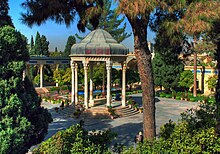
The blossoming literature, philosophy, mathematics, medicine, astronomy and art of Iran became major elements in the formation of a new age for the Iranian civilization, during a period known as the Islamic Golden Age.[122][123] The Islamic Golden Age reached its peak by the 10th and 11th centuries, during which Iran was the main theater of scientific activities.[124] After the 10th century, Persian, alongside Arabic, was used for scientific, medical, philosophical, arithmetical, historical, and musical works, and renowned Iranian writers—such as Tusi, Avicenna, Qotb-od-Din Shirazi, and Biruni—had major contributions in scientific writing. Among Iran's famous medieval scientists, Al-Khwarizmi (whose name was Latinized as Algoritmi) gave a significant role in the development of the Arabic numerals and algebra through his 9th-century work On the Calculation with Hindu Numerals that is globally adopted as the modern numerical system.
The cultural revival that began in the Abbasid period led to a resurfacing of the Iranian national identity; thus, the attempts of Arabization never succeeded in Iran. The Shu'ubiyya movement became a catalyst for Iranians to regain independence in their relations with the Arab invaders.[125] The most notable effect of this movement was the continuation of the Persian language attested to the works of the epic poet Ferdowsi, now considered the most prominent figure in Iranian literature.
The 10th century saw a mass migration of Turkic tribes from Central Asia into the Iranian Plateau.[126] Turkic tribesmen were first used in the Abbasid army as mamluks (slave-warriors), replacing Iranian and Arab elements within the army.[114] As a result, the Mamluks gained a significant political power. In 999, large portions of Iran came briefly under the rule of the Ghaznavids, whose rulers were of mamluk Turkic origin, and longer subsequently under the Seljuk and Khwarezmian empires. These dynasties had been Persianized, and had adopted Persian models of administration and rulership.[126] The Seljuks subsequently gave rise to the Sultanate of Rum in Anatolia, while taking their thoroughly Persianized identity with them.[127][128] The result of the adoption and patronage of Iranian culture by Turkish rulers was the development of a distinct Turko-Persian tradition.
From 1219 to 1221, under the Khwarazmian Empire, Iran suffered a devastating invasion by the Mongol army of Genghis Khan. According to Steven R. Ward, "Mongol violence and depredations killed up to three-fourths of the population of the Iranian Plateau, possibly 10 to 15 million people. Some historians have estimated that Iran's population did not again reach its pre-Mongol levels until the mid-20th century."[129]
Following the fracture of the Mongol Empire in 1256, Hulagu Khan, grandson of Genghis Khan, established the Ilkhanate in Iran. In 1370, yet another conqueror, Timur, followed the example of Hulagu, establishing the Timurid Empire which lasted for another 156 years. In 1387, Timur ordered the complete massacre of Isfahan, reportedly killing 70,000 citizens.[130] The Ilkhans and the Timurids soon came to adopt the ways and customs of the Iranians, surrounding themselves with a culture that was distinctively Iranian.[131]
Early modern period
Safavids
By the 1500s, Ismail I of Ardabil established the Safavid Empire, with his capital at Tabriz.[126] Beginning with Azerbaijan, he subsequently extended his authority over all of the Iranian territories, and established an intermittent Iranian hegemony over the vast relative regions, reasserting the Iranian identity within large parts of Greater Iran.[132] Iran was predominantly Sunni,[133] but Ismail instigated a forced conversion to the Shia branch of Islam,[134] spreading throughout the Safavid territories in the Caucasus, Iran, Anatolia, and Mesopotamia. As a result, modern-day Iran is the only official Shia nation of the world, with it holding an absolute majority in Iran and the Republic of Azerbaijan, having there the first and the second highest number of Shia inhabitants by population percentage in the world.[135][136] Meanwhile, the centuries-long geopolitical and ideological rivalry between Safavid Iran and the neighboring Ottoman Empire led to numerous Ottoman–Iranian wars.[129]
The Safavid era peaked in the reign of Abbas I (1587–1629),[129][137] surpassing their Turkish archrivals in strength, and making Iran a leading science and art hub in western Eurasia. The Safavid era saw the start of mass integration from Caucasian populations into new layers of the society of Iran, as well as mass resettlement of them within the heartlands of Iran, playing a pivotal role in the history of Iran for centuries onwards. Following a gradual decline in the late 1600s and the early 1700s, which was caused by internal conflicts, the continuous wars with the Ottomans, and the foreign interference (most notably the Russian interference), the Safavid rule was ended by the Pashtun rebels who besieged Isfahan and defeated Sultan Husayn in 1722.
Afsharids
In 1729, Nader Shah, a chieftain and military genius from Khorasan, successfully drove out and conquered the Pashtun invaders. He subsequently took back the annexed Caucasian territories which were divided among the Ottoman and Russian authorities by the ongoing chaos in Iran. During the reign of Nader Shah, Iran reached its greatest extent since the Sasanian Empire, reestablishing the Iranian hegemony all over the Caucasus, as well as other major parts of the west and central Asia, and briefly possessing what was arguably the most powerful empire at the time.[31]
Nader Shah invaded India and sacked far off Delhi by the late 1730s. His territorial expansion, as well as his military successes, went into a decline following the final campaigns in the Northern Caucasus against then revolting Lezgins. The assassination of Nader Shah sparked a brief period of civil war and turmoil, after which Karim Khan of the Zand dynasty came to power in 1750, bringing a period of relative peace and prosperity.[129]
Zands
Compared to its preceding dynasties, the geopolitical reach of the Zand dynasty was limited. Many of the Iranian territories in the Caucasus gained de facto autonomy, and were locally ruled through various Caucasian khanates. However, despite the self-ruling, they all remained subjects and vassals to the Zand king.[138] Another civil war ensued after the death of Karim Khan in 1779, out of which Agha Mohammad Khan emerged, founding the Qajar dynasty in 1794.
Qajars
In 1795, following the disobedience of the Georgian subjects and their alliance with the Russians, the Qajars captured Tbilisi by the Battle of Krtsanisi, and drove the Russians out of the entire Caucasus, reestablishing the Iranian suzerainty over the region.

The Russo-Iranian wars of 1804–1813 and 1826–1828 resulted in large irrevocable territorial losses for Iran in the Caucasus, comprising all of Transcaucasia and Dagestan, which made part of the very concept of Iran for centuries,[32] and thus substantial gains for the neighboring Russian Empire.
As a result of the 19th-century Russo-Iranian wars, the Russians took over the Caucasus, and Iran irrevocably lost control over its integral territories in the region (comprising modern-day Dagestan, Georgia, Armenia, and Republic of Azerbaijan), which got confirmed per the treaties of Gulistan and Turkmenchay.[33][139] The area to the north of Aras River, among which the contemporary Republic of Azerbaijan, eastern Georgia, Dagestan, and Armenia are located, were Iranian territory until they were occupied by Russia in the course of the 19th century.[33][140][141][142][143][144][145]
As Iran shrank, many Transcaucasian and North Caucasian Muslims moved towards Iran,[146][147] especially until the aftermath of the Circassian Genocide,[147] and the decades afterwards, while Iran's Armenians were encouraged to settle in the newly incorporated Russian territories,[148][149][150] causing significant demographic shifts.
Around 1.5 million people—20 to 25% of the population of Iran—died as a result of the Great Famine of 1870–1871.[151]

Between 1872 and 1905, a series of protests took place in response to the sale of concessions to foreigners by Qajar monarchs Naser-ed-Din and Mozaffar-ed-Din, and led to the Constitutional Revolution in 1905. The first Iranian constitution and the first national parliament of Iran were founded in 1906, through the ongoing revolution. The Constitution included the official recognition of Iran's three religious minorities, namely Christians, Jews, and Zoroastrians,[152] which has remained a basis in the legislation of Iran since then. The struggle related to the constitutional movement was followed by the Triumph of Tehran in 1909, when Mohammad Ali Shah was defeated and forced to abdicate. On the pretext of restoring order, the Russians occupied northern Iran in 1911 and maintained a military presence in the region for years to come. But this did not put an end to the civil uprisings and was soon followed by Mirza Kuchik Khan's Jungle Movement against both the Qajar monarchy and foreign invaders.
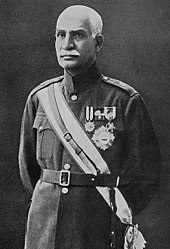
Despite Iran's neutrality during World War I, the Ottoman, Russian and British empires occupied the territory of western Iran and fought the Persian Campaign before fully withdrawing their forces in 1921. At least 2 million Persian civilians died either directly in the fighting, the Ottoman perpetrated anti-Christian genocides or the war induced famine of 1917-1919. A large number of Iranian Assyrian and Iranian Armenian Christians, as well as those Muslims who tried to protect them, were victims of mass murders committed by the invading Ottoman troops, notably in and around Khoy, Maku, Salmas, and Urmia.[153][154][155][156][157]
Apart from the rule of Agha Mohammad Khan, the Qajar rule is characterized as a century of misrule.[126] The inability of Qajar Iran's government to maintain the country's sovereignty during and immediately after World War I led to the British directed 1921 Persian coup d'état and Reza Shah's establishment of the Pahlavi dynasty. Reza Shah, became the new Prime Minister of Iran and was declared the new monarch in 1925.
Pahlavi dynasty
In the midst of World War II, in June 1941, Nazi Germany broke the Molotov–Ribbentrop Pact and invaded the Soviet Union, Iran's northern neighbor. The Soviets quickly allied themselves with the Allied countries and in July and August, 1941 the British demanded that the Iranian government expel all Germans from Iran. Reza Shah refused to expel the Germans and on 25 August, 1941, the British and Soviets launched a surprise invasion and Reza Shah's government quickly surrendered.[158] The invasion's strategic purpose was to secure a supply line to the USSR (later named the Persian Corridor), secure the oil fields and Abadan Refinery (of the UK-owned Anglo-Iranian Oil Company), and limit German influence in Iran. Following the invasion, on 16 September, 1941 Reza Shah abdicated and was replaced by Mohammad Reza Pahlavi, his 21 year old son.[159][160][161]
During the rest of World War II, Iran became a major conduit for British and American aid to the Soviet Union and an avenue through which over 120,000 Polish refugees and Polish Armed Forces fled the Axis advance.[162] At the 1943 Tehran Conference, the Allied "Big Three"—Joseph Stalin, Franklin D. Roosevelt, and Winston Churchill—issued the Tehran Declaration to guarantee the post-war independence and boundaries of Iran. However, at the end of the war, Soviet troops remained in Iran and established two puppet states in north-western Iran, namely the People's Government of Azerbaijan and the Republic of Mahabad. This led to the Iran crisis of 1946, one of the first confrontations of the Cold War, which ended after oil concessions were promised to the USSR and Soviet forces withdrew from Iran proper in May 1946. The two puppet states were soon overthrown and the oil concessions were later revoked.[163][164]
1951–1978: Mosaddegh, Shah Mohammad Reza Pahlavi

In 1951, Mohammad Mosaddegh was appointed as the Prime Minister. He became enormously popular in Iran after he nationalized Iran's petroleum industry and oil reserves. He was deposed in the 1953 Iranian coup d'état, an Anglo-American covert operation that marked the first time the United States had participated in the overthrow of a foreign government during the Cold War.[165]
After the coup, the Shah became increasingly autocratic and sultanistic, and Iran entered a phase of decades-long controversial close relations with the United States and some other foreign governments.[166] While the Shah increasingly modernized Iran and claimed to retain it as a fully secular state,[34] arbitrary arrests and torture by his secret police, the SAVAK, were used to crush all forms of political opposition.[167]
Ruhollah Khomeini, a radical Muslim cleric, became an active critic of the Shah's far-reaching series of reforms known as the White Revolution. Khomeini publicly denounced the government, and was arrested and imprisoned for 18 months. After his release in 1964, he refused to apologize, and was eventually sent into exile.
Due to the 1973 spike in oil prices, the economy of Iran was flooded with foreign currency, which caused inflation. By 1974, the economy of Iran was experiencing double digit inflation, and despite the many large projects to modernize the country, corruption was rampant and caused large amounts of waste. By 1975 and 1976, an economic recession led to increased unemployment, especially among millions of youths who had migrated to the cities of Iran looking for construction jobs during the boom years of the early 1970s. By the late 1970s, many of these people opposed the Shah's regime and began to organize and join the protests against it.[168]
Since the 1979 Islamic Revolution
The 1979 Revolution, later known as the Islamic Revolution,[169][170][171] began in January 1978 with the first major demonstrations against the Shah.[172] After a year of strikes and demonstrations paralyzing the country and its economy, Mohammad Reza Pahlavi fled to the United States, and Ruhollah Khomeini returned from exile to Tehran in February 1979, forming a new government.[173] After holding a referendum, Iran officially became an Islamic republic in April 1979.[174] A second referendum in December 1979 approved a theocratic constitution.[175]
The immediate nationwide uprisings against the new government began with the 1979 Kurdish rebellion and the Khuzestan uprisings, along with the uprisings in Sistan and Baluchestan and other areas. Over the next several years, these uprisings were subdued in a violent manner by the new Islamic government. The new government began purging itself of the non-Islamist political opposition, as well as of those Islamists who were not considered radical enough. Although both nationalists and Marxists had initially joined with Islamists to overthrow the Shah, tens of thousands were executed by the new regime afterwards.[176] Many former ministers and officials in the Shah's government, including former prime minister Amir-Abbas Hoveyda, were executed following Khomeini's order to purge the new government of any remaining officials still loyal to the exiled Shah.
On 4 November 1979, a group of Muslim students seized the United States Embassy and took the embassy with 52 personnel and citizens hostage,[177] after the United States refused to extradite Mohammad Reza Pahlavi to Iran, where his execution was all but assured. Attempts by the Jimmy Carter administration to negotiate for the release of the hostages, and a failed rescue attempt, helped force Carter out of office and brought Ronald Reagan to power. On Jimmy Carter's final day in office, the last hostages were finally set free as a result of the Algiers Accords. Mohammad Reza Pahlavi left the United States for Egypt, where he died of complications from cancer only months later, on 27 July 1980.
The Cultural Revolution began in 1980, with an initial closure of universities for three years, in order to perform an inspection and clean up in the cultural policy of the education and training system.[178]

On 22 September 1980, the Iraqi army invaded the western Iranian province of Khuzestan, launching the Iran–Iraq War. Although the forces of Saddam Hussein made several early advances, by mid 1982, the Iranian forces successfully managed to drive the Iraqi army back into Iraq. In July 1982, with Iraq thrown on the defensive, the regime of Iran took the decision to invade Iraq and conducted countless offensives in a bid to conquer Iraqi territory and capture cities, such as Basra. The war continued until 1988 when the Iraqi army defeated the Iranian forces inside Iraq and pushed the remaining Iranian troops back across the border. Subsequently, Khomeini accepted a truce mediated by the United Nations. The total Iranian casualties in the war were estimated to be 123,220–160,000 KIA, 60,711 MIA, and 11,000–16,000 civilians killed.[179][180]
Following the Iran–Iraq War, in 1989, Akbar Hashemi Rafsanjani and his administration concentrated on a pragmatic pro-business policy of rebuilding and strengthening the economy without making any dramatic break with the ideology of the revolution. In 1997, Rafsanjani was succeeded by moderate reformist Mohammad Khatami, whose government attempted, unsuccessfully, to make the country more free and democratic.[181]
The 2005 presidential election brought conservative populist candidate, Mahmoud Ahmadinejad, to power.[182] By the time of the 2009 Iranian presidential election, the Interior Ministry announced incumbent President Ahmadinejad had won 62.63% of the vote, while Mir-Hossein Mousavi had come in second place with 33.75%.[183][184] The election results were widely disputed,[185][186] and resulted in widespread protests, both within Iran and in major cities outside the country,[187][188] and the creation of the Iranian Green Movement.
Hassan Rouhani was elected as the president on 15 June 2013, defeating Mohammad Bagher Ghalibaf and four other candidates.[189][190] The electoral victory of Rouhani relatively improved the relations of Iran with other countries.[191]

The 2017–18 Iranian protests swept across the country against the government and its longtime Supreme Leader in response to the economic and political situation.[192] The scale of protests throughout the country and the number of people participating were significant,[193] and it was formally confirmed that thousands of protesters were arrested.[194] The 2019–20 Iranian protests started on 15 November in Ahvaz, spreading across the country within hours, after the government announced increases in the fuel price of up to 300%.[195] A week-long total Internet shutdown throughout the country marked one of the most severe Internet blackouts in any country, and according to international observers, tens of thousands were arrested and hundreds were killed within a few days.[196]
On 3 January 2020, the revolutionary guard's general, Qasem Soleimani, was assassinated by the United States in Iraq, which considerably heightened the existing tensions between the two countries.[197] Three days after, Iran's Islamic Revolutionary Guard Corps launched a retaliatory attack on US forces in Iraq and shot down Ukraine International Airlines Flight 752, killing 176 civilians and leading to nation-wide protests. An international investigation led to the government admitting to the shootdown of the plane by a surface-to-air missile after three days of denial, calling it a "human error".[198][199]
Geography
Iran has an area of 1,648,195 km2 (636,372 sq mi).[3] It lies between latitudes 24° and 40° N, and longitudes 44° and 64° E. It is bordered to the northwest by Armenia (35 km or 22 mi), the Azeri exclave of Nakhchivan (179 km or 111 mi),[200] and the Republic of Azerbaijan (611 km or 380 mi); to the north by the Caspian Sea; to the northeast by Turkmenistan (992 km or 616 mi); to the east by Afghanistan (936 km or 582 mi) and Pakistan (909 km or 565 mi); to the south by the Persian Gulf and the Gulf of Oman; and to the west by Iraq (1,458 km or 906 mi) and Turkey (499 km or 310 mi).
Iran consists of the Iranian Plateau, with the exception of the coasts of the Caspian Sea and Khuzestan. It is one of the world's most mountainous countries, its landscape dominated by rugged mountain ranges that separate various basins or plateaux from one another. The populous western part is the most mountainous, with ranges such as the Caucasus, Zagros, and Alborz, the last containing Mount Damavand, Iran's highest point at 5,610 m (18,406 ft), which is also the highest mountain in Asia west of the Hindu Kush.
The northern part of Iran is covered by the lush lowland Caspian Hyrcanian mixed forests, located near the southern shores of the Caspian Sea. The eastern part consists mostly of desert basins, such as the Kavir Desert, which is the country's largest desert, and the Lut Desert, as well as some salt lakes.
The only large plains are found along the coast of the Caspian Sea and at the northern end of the Persian Gulf, where the country borders the mouth of the Arvand river. Smaller, discontinuous plains are found along the remaining coast of the Persian Gulf, the Strait of Hormuz, and the Gulf of Oman.
Climate
Having 11 climates out of the world's 13, Iran's climate is diverse,[201] ranging from arid and semi-arid, to subtropical along the Caspian coast and the northern forests.[202] On the northern edge of the country (the Caspian coastal plain), temperatures rarely fall below freezing and the area remains humid for the rest of the year. Summer temperatures rarely exceed 29 °C (84.2 °F).[203][204] Annual precipitation is 680 mm (26.8 in) in the eastern part of the plain and more than 1,700 mm (66.9 in) in the western part. Gary Lewis, the United Nations Resident Coordinator for Iran, has said that "Water scarcity poses the most severe human security challenge in Iran today".[205]
To the west, settlements in the Zagros basin experience lower temperatures, severe winters with below zero average daily temperatures and heavy snowfall. The eastern and central basins are arid, with less than 200 mm (7.9 in) of rain, and have occasional deserts.[206] Average summer temperatures rarely exceed 38 °C (100.4 °F).[203] The coastal plains of the Persian Gulf and Gulf of Oman in southern Iran have mild winters, and very humid and hot summers. The annual precipitation ranges from 135 to 355 mm (5.3 to 14.0 in).[203]
Fauna
The wildlife of Iran is composed of several animal species, including bears, the Eurasian lynx, foxes, gazelles, gray wolves, jackals, panthers, and wild pigs.[207][208] Other domestic animals of Iran include Asian water buffaloes, camels, cattle, donkeys, goats, horses, and the sheep. Eagles, falcons, partridges, pheasants, and storks are also native to the wildlife of Iran.
One of the most famous members of the Iranian wildlife is the critically endangered Asiatic cheetah, also known as the Iranian cheetah, whose numbers were greatly reduced after the 1979 Revolution.[209] The Persian leopard, which is the world's largest leopard subspecies living primarily in northern Iran, is also listed as an endangered species.[210] Iran lost all its Asiatic lions and the now extinct Caspian tigers by the earlier part of the 20th century.[211]
At least 74 species of the Iranian wildlife are on the red list of the International Union for Conservation of Nature, a sign of serious threats against the country's biodiversity. The Iranian Parliament has been showing disregard for wildlife by passing laws and regulations such as the act that lets the Ministry of Industries and Mines exploit mines without the involvement of the Department of Environment, and by approving large national development projects without demanding comprehensive study of their impact on wildlife habitats.[212]
Administrative divisions
Iran is divided into five regions with thirty-one provinces (ostān),[213] each governed by an appointed governor (ostāndār). The provinces are divided into counties (šahrestān), and subdivided into districts (baxš) and sub-districts (dehestān).
The country has one of the highest urban growth rates in the world. From 1950 to 2002, the urban proportion of the population increased from 27% to 60%.[214] The United Nations predicts that by 2030, 80% of the population will be urban.[215][failed verification] Most internal migrants have settled around the cities of Tehran, Isfahan, Ahvaz, and Qom. The listed populations are from the 2006/07 (1385 AP) census.[216][failed verification]
Tehran, with a population of around 8.8 million (2016 census), is the capital and largest city of Iran. It is an economical and cultural center, and is the hub of the country's communication and transport network.
The country's second most populous city, Mashhad, has a population of around 3.3 million (2016 census), and is capital of the province of Razavi Khorasan. Being the site of the Imam Reza Shrine, it is a holy city in Shia Islam. About 15 to 20 million pilgrims visit the shrine every year.[217][218]
Isfahan has a population of around 2.2 million (2016 census), and is Iran's third most populous city. It is the capital of the province of Isfahan, and was also the third capital of the Safavid Empire. It is home to a wide variety of historical sites, including the famous Shah Square, Siosepol, and the churches at the Armenian district of New Julfa. It is also home to the world's seventh largest shopping mall, Isfahan City Center.
The fourth most populous city of Iran, Karaj, has a population of around 1.9 million (2016 census). It is the capital of the province of Alborz, and is situated 20 km west of Tehran, at the foot of the Alborz mountain range. It is a major industrial city in Iran, with large factories producing sugar, textiles, wire, and alcohol.
With a population of around 1.7 million (2016 census), Tabriz is the fifth most populous city of Iran, and had been the second most populous until the late 1960s. It was the first capital of the Safavid Empire, and is now the capital of the province of East Azerbaijan. It is also considered the country's second major industrial city (after Tehran).
Shiraz, with a population of around 1.8 million (2016 census), is Iran's sixth most populous city. It is the capital of the province of Fars, and was also the capital of Iran under the reign of the Zand dynasty. It is located near the ruins of Persepolis and Pasargadae, two of the four capitals of the Achaemenid Empire.
Largest cities or towns in Iran
2016 census | |||||||||
|---|---|---|---|---|---|---|---|---|---|
| Rank | Name | Province | Pop. | Rank | Name | Province | Pop. | ||
 Tehran  Mashhad |
1 | Tehran | Tehran | 8,693,706 | 11 | Rasht | Gilan | 679,995 |  Isfahan  Karaj |
| 2 | Mashhad | Razavi Khorasan | 3,001,184 | 12 | Zahedan | Sistan and Baluchestan | 587,730 | ||
| 3 | Isfahan | Isfahan | 1,961,260 | 13 | Hamadan | Hamadan | 554,406 | ||
| 4 | Karaj | Alborz | 1,592,492 | 14 | Kerman | Kerman | 537,718 | ||
| 5 | Shiraz | Fars | 1,565,572 | 15 | Yazd | Yazd | 529,673 | ||
| 6 | Tabriz | East Azarbaijan | 1,558,693 | 16 | Ardabil | Ardabil | 529,374 | ||
| 7 | Qom | Qom | 1,201,158 | 17 | Bandar Abbas | Hormozgan | 526,648 | ||
| 8 | Ahvaz | Khuzestan | 1,184,788 | 18 | Arak | Markazi | 520,944 | ||
| 9 | Kermanshah | Kermanshah | 946,651 | 19 | Eslamshahr | Tehran | 448,129 | ||
| 10 | Urmia | West Azarbaijan | 736,224 | 20 | Zanjan | Zanjan | 430,871 | ||
Government and politics
The political system of the Islamic Republic is based on the 1979 Constitution.[219] According to international reports, Iran's human rights record is exceptionally poor. The regime in Iran is undemocratic,[220][221] has frequently persecuted and arrested critics of the government and its Supreme Leader, and severely restricts the participation of candidates in popular elections as well as other forms of political activity.[222][223] Women's rights in Iran are described as seriously inadequate,[224] and children's rights have been severely violated, with more child offenders being executed in Iran than in any other country in the world.[225][226] Sexual activity between members of the same sex is illegal and is punishable by up to death.[227][228] Since the 2000s, Iran's controversial nuclear program has raised concerns, which is part of the basis of the international sanctions against the country. The Joint Comprehensive Plan of Action, an agreement reached between Iran and the P5+1, was created on 14 July 2015, aimed to loosen the nuclear sanctions in exchange for Iran's restriction in producing enriched uranium.
Over the past decade, numbers of anti-government protests have broken out throughout Iran (such as the 2019–20 Iranian protests), demanding reforms or the end to the Islamic Republic. However, the IRGC and police often suppressed mass protests by violent means, which resulted in thousands of protesters killed.
Supreme Leader

The Leader of the Revolution ("Supreme Leader") is responsible for delineation and supervision of the policies of the Islamic Republic of Iran.[231] The Iranian president has limited power compared to the Supreme Leader Khamenei.[232] The current longtime Supreme Leader, Ali Khamenei, has been issuing decrees and making the final decisions on the economy, environment, foreign policy, education, national plannings, and everything else in the country.[233][234][235][236][237][238][239][240][241] Khamenei also outlines elections guidelines and urges for the transparency,[242] and has fired and reinstated presidential cabinet appointments.[243][244] Key ministers are selected with the Supreme Leader Ali Khamenei's agreement and he has the ultimate say on Iran's foreign policy.[232] The president-elect is required to gain the Leader Khamenei's official approval before being sworn in before the Parliament (Majlis). Through this process, known as Tanfiz (validation), the Leader agrees to the outcome of the presidential election.[245] The Supreme Leader is directly involved in ministerial appointments for Defense, Intelligence and Foreign Affairs, as well as other top ministries after submission of candidates from the president.[246] Iran's regional policy is directly controlled by the office of the Supreme Leader with the Ministry of Foreign Affairs' task limited to protocol and ceremonial occasions. All of Iran's ambassadors to Arab countries, for example, are chosen by the Quds Corps, which directly reports to the Supreme Leader.[233] The budget bill for every year, as well as withdrawing money from the National Development Fund of Iran, require Supreme Leader Ali Khamenei's approval and permission.[247] The Supreme Leader Khamenei can and did order laws to be amended.[248] Setad, estimated at $95 billion in 2013 by the Reuters, accounts of which are secret even to the Iranian parliament,[249][250] is controlled only by the Supreme Leader.[251][252]
The Supreme Leader is the commander-in-chief of the armed forces, controls the military intelligence and security operations, and has sole power to declare war or peace.[231] The heads of the judiciary, the state radio and television networks, the commanders of the police and military forces, and six of the twelve members of the Guardian Council are directly appointed by the Supreme Leader.[231]
The Assembly of Experts is responsible for electing the Supreme Leader, and has the power to dismiss him on the basis of qualifications and popular esteem.[253] To date, the Assembly of Experts has not challenged any of the Supreme Leader's decisions, nor has it attempted to dismiss him.[254] The previous head of the judicial system, Sadeq Larijani, appointed by the Supreme Leader, said that it is illegal for the Assembly of Experts to supervise the Supreme Leader.[255] Due to Khamenei's very longtime unchallenged rule, many believe the Assembly of Experts has become a ceremonial body without any real power.[256][257][258][259] There have been instances when the current Supreme Leader publicly criticized members of the Assembly of Experts, resulting in their arrest and dismissal. For example, Khamenei publicly called then-member of the Assembly of Experts Ahmad Azari Qomi a traitor, resulting in Qomi's arrest and eventual dismissal from the Assembly of Experts. Another instance is when Khamenei indirectly called Akbar Hashemi Rafsanjani a traitor for a statement he made, causing Rafsanjani to retract it.[260]
Guardian Council
Presidential candidates and parliamentary candidates must be approved by the Guardian Council (all members of which are directly or indirectly appointed by the Leader) or the Leader before running, in order to ensure their allegiance to the Supreme Leader.[261] The Leader very rarely does the vetting himself directly, but has the power to do so, in which case additional approval of the Guardian Council would not be needed. The Leader can also revert the decisions of the Guardian Council.[262] The Guardian Council can, and has dismissed some elected members of the Iranian parliament in the past.[263] For example, Minoo Khaleghi was disqualified by Guardian Council even after winning election, as she had been photographed in a meeting without wearing headscarf.[264]
President

After the Supreme Leader, the Constitution defines the President of Iran as the highest state authority.[231][268] The President is elected by universal suffrage for a term of four years, however, the president is still required to gain the Leader's official approval before being sworn in before the Parliament (Majlis). The Leader also has the power to dismiss the elected president anytime.[269] The President can only be re-elected for one term.[268]

The President is responsible for the implementation of the constitution, and for the exercise of executive powers in implementing the decrees and general policies as outlined by the Supreme Leader, except for matters directly related to the Supreme Leader, who has the final say in all matters.[231] Unlike the executive in other countries, the President of Iran does not have full control over anything, as these are ultimately under the control of the Supreme Leader.[219] Chapter IX of the Constitution of the Islamic Republic of Iran sets forth the qualifications for presidential candidates. The procedures for presidential election and all other elections in Iran are outlined by the Supreme Leader.[242][270] The President functions as the executive of affairs such as signing treaties and other international agreements, and administering national planning, budget, and state employment affairs, all as approved by the Supreme Leader.[234][235][270][236][237][238][239][240][271]
The President appoints the ministers, subject to the approval of the Parliament, as well as the approval of the Supreme Leader, who can dismiss or reinstate any of the ministers at any time, regardless of the decisions made by the President or the Parliament.[243][244][272] The President supervises the Council of Ministers, coordinates government decisions, and selects government policies to be placed before the legislature.[273] The current Supreme Leader, Ali Khamenei, has fired as well as reinstated Council of Ministers members.[274][275] Eight Vice Presidents serve under the President, as well as a cabinet of twenty-two ministers, who must all be approved by the legislature.[276]
Legislature
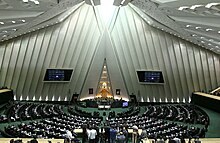
The legislature of Iran, known as the Islamic Consultative Assembly, is a unicameral body comprising 290 members elected for four-year terms.[277] It drafts legislation, ratifies international treaties, and approves the national budget. All parliamentary candidates and all legislation from the assembly must be approved by the Guardian Council.[278]
The Guardian Council comprises twelve jurists, including six appointed by the Supreme Leader. Others are elected by the Parliament, from among the jurists nominated by the Head of the Judiciary.[279][280] The Council interprets the constitution and may veto the Parliament. If a law is deemed incompatible with the constitution or Sharia (Islamic law), it is referred back to the Parliament for revision.[268] The Expediency Council has the authority to mediate disputes between the Parliament and the Guardian Council, and serves as an advisory body to the Supreme Leader, making it one of the most powerful governing bodies in the country.[281] Local city councils are elected by public vote to four-year terms in all cities and villages of Iran.
Law
The Supreme Leader appoints the head of the country's judiciary, who in turn appoints the head of the Supreme Court and the chief public prosecutor.[254] There are several types of courts, including public courts that deal with civil and criminal cases, and revolutionary courts which deal with certain categories of offenses, such as crimes against national security. The decisions of the revolutionary courts are final and cannot be appealed.[254]
The Special Clerical Court handles crimes allegedly committed by clerics, although it has also taken on cases involving laypeople. The Special Clerical Court functions independently of the regular judicial framework, and is accountable only to the Supreme Leader. The Court's rulings are final and cannot be appealed.[254] The Assembly of Experts, which meets for one week annually, comprises 86 "virtuous and learned" clerics elected by adult suffrage for eight-year terms.
Foreign relations

The officially stated goal of the government of Iran is to establish a new world order based on world peace, global collective security, and justice.[282][283] Since the time of the 1979 Revolution, Iran's foreign relations have often been portrayed as being based on two strategic principles; eliminating outside influences in the region, and pursuing extensive diplomatic contacts with developing and non-aligned countries.[284]
Since 2005, Iran's nuclear program has become the subject of contention with the international community, mainly the United States. Many countries have expressed concern that Iran's nuclear program could divert civilian nuclear technology into a weapons program. This has led the United Nations Security Council to impose sanctions against Iran which had further isolated Iran politically and economically from the rest of the global community. In 2009, the U.S. Director of National Intelligence said that Iran, if choosing to, would not be able to develop a nuclear weapon until 2013.[285]

As of 2009[update], the government of Iran maintains diplomatic relations with 99 members of the United Nations,[286] but not with the United States, and not with Israel—a state which Iran's government has derecognized since the 1979 Revolution.[287] Among Muslim nations, Iran has an adversarial relationship with Saudi Arabia due to different political and Islamic ideologies. While Iran is a Shia Islamic Republic, Saudi Arabia is a conservative Sunni monarchy.[288] Regarding the Israeli–Palestinian conflict, the government of Iran has recognized Jerusalem as the capital of the State of Palestine, after Trump recognized Jerusalem as the capital of Israel.[289][290][291]
On 14 July 2015, Tehran and the P5+1 came to a historic agreement (Joint Comprehensive Plan of Action) to end economic sanctions after demonstrating a peaceful nuclear research project that would meet the International Atomic Energy Agency standards.[292]
Iran is a member of dozens of international organizations, including the G-15, G-24, G-77, IAEA, IBRD, IDA, IDB, IFC, ILO, IMF, IMO, Interpol, OIC, OPEC,[293] WHO, and the United Nations, and currently has observer status at the World Trade Organization.
In September 2018, the Iranian ambassador to the United Nations asked the UN to condemn Israeli threats against Tehran and also bring Israel's nuclear program under the International Atomic Energy Agency's supervision.[294]
In April 2019 the U.S. threatened to sanction countries continuing to buy oil from Iran after an initial six-month waiver announced in November expired.[295] According to the BBC, U.S. sanctions against Iran "have led to a sharp downturn in Iran's economy, pushing the value of its currency to record lows, quadrupling its annual inflation rate, driving away foreign investors, and triggering protests."[296]
On 1 September 2019, the Iranian authorities took a step to enhance its relations with Qatar, and decided to grant Qatari passport holders tourist visas upon arrival at Iranian airports. Besides, Qatari nationals were also permitted to obtain a single or multiple-entry visa from Iran's embassy in Doha.[297]
Military
The Islamic Republic of Iran has two types of armed forces: the regular forces of the Army, the Air Force, and the Navy, and the Revolutionary Guards, totaling about 545,000 active troops. Iran also has around 350,000 Reserve Force, totaling around 900,000 trained troops.[298]
The government of Iran has a paramilitary, volunteer militia force within the Islamic Revolutionary Guard Corps, called the Basij, which includes about 90,000 full-time, active-duty uniformed members. Up to 11 million men and women are members of the Basij who could potentially be called up for service. GlobalSecurity.org estimates Iran could mobilize "up to one million men", which would be among the largest troop mobilizations in the world.[299] In 2007, Iran's military spending represented 2.6% of the GDP or $102 per capita, the lowest figure of the Persian Gulf nations.[300] Iran's military doctrine is based on deterrence.[301] In 2014, the country spent $15 billion on arms, while the states of the Gulf Cooperation Council spent eight times more.[302] The United States under President Donald Trump officially labeled the Revolutionary Guard as a foreign terrorist organization. It is the first time that an element of a foreign state was designated as a terrorist organization.[303][304]
The government of Iran supports the military activities of its allies in Syria, Iraq, and Lebanon (Hezbollah) with military and financial aid.[305] Iran and Syria are close strategic allies, and Iran has provided significant support for the Syrian Government in the Syrian Civil War.[306] According to some estimates, Iran controlled over 80,000 pro-Assad Shi'ite fighters in Syria.[306][307]
Since the 1979 Revolution, to overcome foreign embargoes, the government of Iran has developed its own military industry, produced its own tanks, armored personnel carriers, missiles, submarines, military vessels, missile destroyer, radar systems, helicopters, and fighter planes.[308] In recent years, official announcements have highlighted the development of weapons such as the Hoot, Kowsar, Zelzal, Fateh-110, Shahab-3, Sejjil, and a variety of unmanned aerial vehicles (UAVs).[309] Iran has the largest and most diverse ballistic missile arsenal in the Middle East.[310] The Fajr-3, a liquid fuel missile with an undisclosed range which was developed and produced domestically, is currently the most advanced ballistic missile of the country.
Mandatory military service
In June 1925, Reza Shah introduced conscription law at National Consultative Majlis. At that time every male person who had reached 21 years old must serve for military for two years. The conscription exempted women from military service after 1979 revolution. Iranian constitution obliges all men of 18 years old and higher to serve in military or police bases. They cannot leave the country or be employed without completion of the service period.[311] The period varies from 18 to 24 months. Inappropriate situation of Iranian soldiers has caused violent incidents in recent years.[312][313] Most of Iranian soldiers suffer from depression.[314][315] In addition, some researches have reported high rate of suicide among Iranian conscripts.[316][317][318]
Economy
| Year | Share |
| 1980 | 1.90% |
| 1990 | 1.52% |
| 2000 | 1.33% |
| 2010 | 1.45% |
| 2017 | 1.30% |

Iran's economy is a mixture of central planning, state ownership of oil and other large enterprises, village agriculture, and small-scale private trading and service ventures.[320] In 2017, GDP was $427.7 billion ($1.631 trillion at PPP), or $20,000 at PPP per capita.[3] Iran is ranked as an upper-middle income economy by the World Bank.[321] In the early 21st century, the service sector contributed the largest percentage of the GDP, followed by industry (mining and manufacturing) and agriculture.[322]
The Central Bank of the Islamic Republic of Iran is responsible for developing and maintaining the Iranian rial, which serves as the country's currency. The government does not recognize trade unions other than the Islamic labour councils, which are subject to the approval of employers and the security services.[323] The minimum wage in June 2013 was 487 million rials a month ($134).[324] Unemployment has remained above 10% since 1997, and the unemployment rate for women is almost double that of the men.[324]
In 2006, about 45% of the government's budget came from oil and natural gas revenues, and 31% came from taxes and fees.[326] As of 2007[update], Iran had earned $70 billion in foreign-exchange reserves, mostly (80%) from crude oil exports.[327] Iranian budget deficits have been a chronic problem, mostly due to large-scale state subsidies, that include foodstuffs and especially gasoline, totaling more than $84 billion in 2008 for the energy sector alone.[328][329] In 2010, the economic reform plan was approved by parliament to cut subsidies gradually and replace them with targeted social assistance. The objective is to move towards free market prices in a five-year period and increase productivity and social justice.[330]
The administration continues to follow the market reform plans of the previous one, and indicates that it will diversify Iran's oil-reliant economy. Iran has also developed a biotechnology, nanotechnology, and pharmaceutical industry.[331] However, nationalized industries such as the bonyads have often been managed badly, making them ineffective and uncompetitive with years. Currently, the government is trying to privatize these industries, and, despite successes, there are still several problems to be overcome, such as the lagging corruption in the public sector and lack of competitiveness.
Iran has leading manufacturing industries in the fields of automobile manufacture, transportation, construction materials, home appliances, food and agricultural goods, armaments, pharmaceuticals, information technology, and petrochemicals in the Middle East.[332] According to the 2012 data from the Food and Agriculture Organization, Iran has been among the world's top five producers of apricots, cherries, sour cherries, cucumbers and gherkins, dates, eggplants, figs, pistachios, quinces, walnuts, and watermelons.[333]
Economic sanctions against Iran, such as the embargo against Iranian crude oil, have affected the economy.[334] Sanctions have led to a steep fall in the value of the rial, and as of April 2013[update], one US dollar is worth 36,000 rial, compared with 16,000 in early 2012.[335] In 2018, after the withdrawal of the US from the JCPOA, the price of dollar hit an all-time high at just over 190,000 rials, which halted the market from trades and stores from selling goods, particularly in the consumer electronics sector[336] until the prices were stable. In 2015, Iran and the P5+1 reached a deal on the nuclear program that removed the main sanctions pertaining to Iran's nuclear program by 2016.[337]
Tourism
Although tourism declined significantly during the war with Iraq, it has been subsequently recovered.[339] About 1,659,000 foreign tourists visited Iran in 2004, and 2.3 million in 2009, mostly from Asian countries, including the republics of Central Asia, while about 10% came from the European Union and North America.[340][341][342] Since the removal of some sanctions against Iran in 2015, tourism has re-surged in the country. Over five million tourists visited Iran in the fiscal year of 2014–2015, four percent more than the previous year.[343][344]
Alongside the capital, the most popular tourist destinations are Isfahan, Mashhad, and Shiraz.[345] In the early 2000s, the industry faced serious limitations in infrastructure, communications, industry standards, and personnel training.[346] The majority of the 300,000 travel visas granted in 2003 were obtained by Asian Muslims, who presumably intended to visit pilgrimage sites in Mashhad and Qom.[342] Several organized tours from Germany, France, and other European countries come to Iran annually to visit archaeological sites and monuments. In 2003, Iran ranked 68th in tourism revenues worldwide.[347] According to the UNESCO and the deputy head of research for Iran's Tourism Organization, Iran is rated fourth among the top 10 destinations in the Middle East.[347] Domestic tourism in Iran is one of the largest in the world.[348][349][350] Weak advertising, unstable regional conditions, a poor public image in some parts of the world, and absence of efficient planning schemes in the tourism sector have all hindered the growth of tourism.
Energy
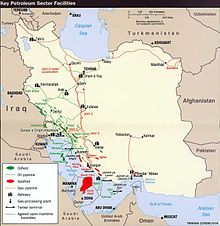
Iran has the world's second largest proved gas reserves after Russia, with 33.6 trillion cubic metres,[352] and the third largest natural gas production after Indonesia and Russia. It also ranks fourth in oil reserves with an estimated 153,600,000,000 barrels.[353][354] It is OPEC's second largest oil exporter, and is an energy superpower.[355] In 2005, Iran spent US$4 billion on fuel imports, because of contraband and inefficient domestic use.[356] Oil industry output averaged 4 million barrels per day (640,000 m3/d) in 2005, compared with the peak of six million barrels per day reached in 1974. In the early 2000s, industry infrastructure was increasingly inefficient because of technological lags. Few exploratory wells were drilled in 2005.
In 2004, a large share of Iran's natural gas reserves were untapped. The addition of new hydroelectric stations and the streamlining of conventional coal and oil-fired stations increased installed capacity to 33,000 megawatts. Of that amount, about 75% was based on natural gas, 18% on oil, and 7% on hydroelectric power. In 2004, Iran opened its first wind-powered and geothermal plants, and the first solar thermal plant was to come online in 2009. Iran is the world's third country to have developed GTL technology.[357]
Demographic trends and intensified industrialization have caused electric power demand to grow by 8% per year. The government's goal of 53,000 megawatts of installed capacity by 2010 is to be reached by bringing on line new gas-fired plants, and adding hydropower and nuclear power generation capacity. Iran's first nuclear power plant at Bushire went online in 2011. It is the second nuclear power plant ever built in the Middle East after the Metsamor Nuclear Power Plant in Armenia.[358][359]
In 2020 Fatih Birol the head of the International Energy Agency said that fossil fuel subsidies should be redirected, for example to the health system.[360]
Education, science and technology
Education in Iran is highly centralized. K–12 is supervised by the Ministry of Education, and higher education is under the supervision of the Ministry of Science and Technology. The adult literacy rated 93.0% in September 2015,[361] while it had rated 85.0% in 2008, up from 36.5% in 1976.[362]
The requirement to enter into higher education is to have a high school diploma and pass the Iranian University Entrance Exam (officially known as konkur (کنکور)), which is the equivalent of the SAT and ACT exams of the United States. Many students do a 1–2-year course of pre-university (piš-dānešgāh), which is the equivalent of the GCE A-levels and the International Baccalaureate. The completion of the pre-university course earns students the Pre-University Certificate.[363]

Iran's higher education is sanctioned by different levels of diplomas, including an associate degree (kārdāni; also known as fowq e diplom) delivered in two years, a bachelor's degree (kāršenāsi; also known as lisāns) delivered in four years, and a master's degree (kāršenāsi e aršad) delivered in two years, after which another exam allows the candidate to pursue a doctoral program (PhD; known as doktorā).[364]
According to the Webometrics Ranking of World Universities (as of January 2017[update]), Iran's top five universities include Tehran University of Medical Sciences (478th worldwide), the University of Tehran (514th worldwide), Sharif University of Technology (605th worldwide), Amirkabir University of Technology (726th worldwide), and the Tarbiat Modares University (789th worldwide).[365]
Iran has increased its publication output nearly tenfold from 1996 through 2004, and has been ranked first in terms of output growth rate, followed by China.[366] According to a study by SCImago in 2012, Iran would rank fourth in the world in terms of research output by 2018, if the current trend persists.[367]
In 2009, a SUSE Linux-based HPC system made by the Aerospace Research Institute of Iran (ARI) was launched with 32 cores, and now runs 96 cores. Its performance was pegged at 192 GFLOPS.[368] The Iranian humanoid robot Sorena 2, which was designed by engineers at the University of Tehran, was unveiled in 2010. The Institute of Electrical and Electronics Engineers (IEEE) has placed the name of Surena among the five prominent robots of the world after analyzing its performance.[369]
In the biomedical sciences, Iran's Institute of Biochemistry and Biophysics has a UNESCO chair in biology.[370] In late 2006, Iranian scientists successfully cloned a sheep by somatic cell nuclear transfer, at the Royan Research Center in Tehran.[371]
According to a study by David Morrison and Ali Khadem Hosseini (Harvard-MIT and Cambridge), stem cell research in Iran is amongst the top 10 in the world.[372] Iran ranks 15th in the world in nanotechnologies.[373][374][375]

Iran placed its domestically built satellite Omid into orbit on the 30th anniversary of the 1979 Revolution, on 2 February 2009,[376] through its first expendable launch vehicle Safir, becoming the ninth country in the world capable of both producing a satellite and sending it into space from a domestically made launcher.[377]
The Iranian nuclear program was launched in the 1950s. Iran is the seventh country to produce uranium hexafluoride, and controls the entire nuclear fuel cycle.[378][379]
Iranian scientists outside Iran have also made some major contributions to science. In 1960, Ali Javan co-invented the first gas laser, and fuzzy set theory was introduced by Lotfi A. Zadeh.[380] Iranian cardiologist Tofigh Mussivand invented and developed the first artificial cardiac pump, the precursor of the artificial heart. Furthering research and treatment of diabetes, the HbA1c was discovered by Samuel Rahbar. Iranian physics is especially strong in string theory, with many papers being published in Iran.[381] Iranian American string theorist Kamran Vafa proposed the Vafa–Witten theorem together with Edward Witten. In August 2014, Iranian mathematician Maryam Mirzakhani became the first woman, as well as the first Iranian, to receive the Fields Medal, the highest prize in mathematics.[382]
Demographics
| 1956–2011 | ||
|---|---|---|
| Year | Pop. | ±% p.a. |
| 1956 | 18,954,704 | — |
| 1966 | 25,785,210 | +3.13% |
| 1976 | 33,708,744 | +2.72% |
| 1986 | 49,445,010 | +3.91% |
| 1996 | 60,055,488 | +1.96% |
| 2006 | 70,495,782 | +1.62% |
| 2011 | 75,149,669 | +1.29% |
| 2018 | 81,672,300 | +1.20% |
| Source: United Nations Demographic Yearbook[383] 2018 data[14] | ||
Iran is a diverse country, consisting of numerous ethnic and linguistic groups that are unified through a shared Iranian nationality.[384]
Iran's population grew rapidly during the latter half of the 20th century, increasing from about 19 million in 1956 to around 75 million by 2009.[385][386] However, Iran's birth rate has dropped significantly in recent years, leading to a population growth rate of about 1.20% as of 2018.[387] Due to its young population, studies project that the growth will continue to slow until it stabilizes around 105 million by 2050.[388][389][390]
Iran hosts one of the largest refugee populations in the world, with more than one million refugees, mostly from Afghanistan and Iraq.[391] Since 2006, Iranian officials have been working with the UNHCR and Afghan officials for their repatriation.[392] According to estimates, about five million Iranian citizens have emigrated to other countries, mostly since the 1979 Revolution.[393][394]
According to the Iranian Constitution, the government is required to provide every citizen of the country with access to social security, covering retirement, unemployment, old age, disability, accidents, calamities, health and medical treatment and care services.[395] This is covered by tax revenues and income derived from public contributions.[396]
Languages
The majority of the population speak Persian, which is also the official language of the country. Others include speakers of a number of other Iranian languages within the greater Indo-European family, and languages belonging to some other ethnicities living in Iran.
In northern Iran, mostly confined to Gilan and Mazenderan, the Gilaki and Mazenderani languages are widely spoken, both having affinities to the neighboring Caucasian languages. In parts of Gilan, the Talysh language is also widely spoken, which stretches up to the neighboring Republic of Azerbaijan. Varieties of Kurdish are widely spoken in the province of Kurdistan and nearby areas. In Khuzestan, several distinct varieties of Persian are spoken. Luri and Lari are also spoken in southern Iran.
Azerbaijani, which is by far the most spoken language in the country after Persian,[397] as well as a number of other Turkic languages and dialects, is spoken in various regions of Iran, especially in the region of Azerbaijan.
Notable minority languages in Iran include Armenian, Georgian, Neo-Aramaic, and Arabic. Khuzi Arabic is spoken by the Arabs in Khuzestan, as well as the wider group of Iranian Arabs. Circassian was also once widely spoken by the large Circassian minority, but, due to assimilation over the many years, no sizable number of Circassians speak the language anymore.[398][399][400][401]
Percentages of spoken language continue to be a point of debate, as many opt that they are politically motivated; most notably regarding the largest and second largest ethnicities in Iran, the Persians and Azerbaijanis. Percentages given by the CIA's World Factbook include 53% Persian, 16% Azerbaijani, 10% Kurdish, 7% Mazenderani and Gilaki, 7% Luri, 2% Turkmen, 2% Balochi, 2% Arabic, and 2% the remainder Armenian, Georgian, Neo-Aramaic, and Circassian.[3]
Ethnic groups
As with the spoken languages, the ethnic group composition also remains a point of debate, mainly regarding the largest and second largest ethnic groups, the Persians and Azerbaijanis, due to the lack of Iranian state censuses based on ethnicity. The CIA's World Factbook has estimated that around 79% of the population of Iran are a diverse Indo-European ethno-linguistic group that comprise speakers of various Iranian languages,[402] with Persians (including Mazenderanis and Gilaks) constituting 61% of the population, Kurds 10%, Lurs 6%, and Balochs 2%. Peoples of other ethno-linguistic groups make up the remaining 21%, with Azerbaijanis constituting 16%, Arabs 2%, Turkmens and other Turkic tribes 2%, and others (such as Armenians, Talysh, Georgians, Circassians, Assyrians) 1%.[3]
The Library of Congress issued slightly different estimates: 65% Persians (including Mazenderanis, Gilaks, and the Talysh), 16% Azerbaijanis, 7% Kurds, 6% Lurs, 2% Baloch, 1% Turkic tribal groups (incl. Qashqai and Turkmens), and non-Iranian, non-Turkic groups (incl. Armenians, Georgians, Assyrians, Circassians, and Arabs) less than 3%. It determined that Persian is the first language of at least 65% of the country's population, and is the second language for most of the remaining 35%.[403]
Other nongovernmental estimates regarding the groups other than Persians and Azerbaijanis are roughly congruent with the World Factbook and the Library of Congress. However, many estimates regarding the number of these two groups differ significantly from the mentioned census; some place the number of ethnic Azerbaijanis in Iran between 21.6–30% of the total population, with the majority holding it on 25%.c[404]d[405][406][407][408][409] In any case, the largest population of Azerbaijanis in the world live in Iran.
Religion
The neutrality of this section is disputed. (May 2020) (Learn how and when to remove this template message) |
| Religion | Percent | Number |
| Muslim | 99.3989% (90–95% Shia) |
74,682,938 |
| Christian | 0.1566% | 117,704 |
| Zoroastrian | 0.0336% | 25,271 |
| Jewish | 0.0117% | 8,756 |
| Other | 0.0653% | 49,101 |
| Undeclared | 0.3538% | 205,317 |
Historically, early Iranian religions such as the Proto-Iranic religion and the subsequent Zoroastrianism and Manichaeism were the dominant religions in Iran, particularly during the Median, Achaemenid, Parthian, and Sasanian eras. This changed after the fall of the Sasanian Empire by the centuries-long Islamization that followed the Muslim Conquest of Iran. Iran was predominantly Sunni until the conversion of the country (as well as the people of what is today the neighboring Republic of Azerbaijan) to Shia Islam by the order of the Safavid dynasty in the 16th century.[133]
Today, Twelver Shia Islam is the official state religion, to which about 90% to 95%[411][412] of the population adhere. About 4% to 8% of the population are Sunni Muslims, mainly Kurds and Baloches. The remaining 2% are non-Muslim religious minorities, including Christians, Jews, Bahais, Mandeans, Yezidis, Yarsanis, and Zoroastrians.[3][413]
There are about 3,000,000 adherents of Yarsanism, a Kurdish indigenous religion related to Zoroastrianism: making it the largest (unrecognized) minority religion in Iran. Its followers are mainly Gorani Kurds and certain groups of Lurs. They are based in Kurdistan Province, Kermanshah Province and Lorestan mainly.
Judaism has a long history in Iran, dating back to the Achaemenid conquest of Babylonia. Although many left in the wake of the establishment of the State of Israel and the 1979 Revolution, about 8,756[414] to 25,000[415] Jewish people live in Iran. Iran has the largest Jewish population in the Middle East outside of Israel.[416]
Around 250,000 to 370,000 Christians reside in Iran,[417][418] and Christianity is the country's largest recognized minority religion. Most are of Armenian background, as well as a sizable minority of Assyrians.[419]
Christianity, Judaism, Zoroastrianism, and the Sunni branch of Islam are officially recognized by the government, and have reserved seats in the Iranian Parliament.[152] But the Bahá'í Faith, which is said to be the largest non-Muslim religious minority in Iran[420] is not officially recognized, and has been persecuted during its existence in Iran since the 19th century, while according to statistics center of Iran, Bahais constitute only about 0.37% of Iran, namely about 25.000 to 40.000 people, and it is also said that there does seem to be a kind of exaggeration in declaration of their population by the order of Bahais heads.[421][422] Since the 1979 Revolution, the persecution of Bahais has increased with executions and denial of civil rights, especially the denial of access to higher education and employment.[423][424][425]
Culture
The earliest attested cultures in Iran date back to the Lower Paleolithic. Owing to its geopolitical position, Iran has influenced cultures as far as Greece and Italy to the west, Russia to the north, the Arabian Peninsula to the south, and south and east Asia to the east.
Art
The art of Iran encompasses many disciplines, including architecture, stonemasonry, metalworking, weaving, pottery, painting, and calligraphy. Iranian works of art show a great variety in style, in different regions and periods.[426] The art of the Medes remains obscure, but has been theoretically attributed to the Scythian style.[427] The Achaemenids borrowed heavily from the art of their neighboring civilizations,[428] but produced a synthesis of a unique style,[429] with an eclectic architecture remaining at sites such as Persepolis and Pasargadae. Greek iconography was imported by the Seleucids, followed by the recombination of Hellenistic and earlier Near Eastern elements in the art of the Parthians,[430] with remains such as the Temple of Anahita and the Statue of the Parthian Nobleman. By the time of the Sasanians, Iranian art came across a general renaissance.[431] Although of unclear development,[432] Sasanian art was highly influential, and spread into far regions. Taq-e-Bostan, Taq-e-Kasra, Naqsh-e-Rostam, and the Shapur-Khwast Castle are among the surviving monuments from the Sasanian period.
During the Middle Ages, Sasanian art played a prominent role in the formation of both European and Asian medieval art,[101] which carried forward to the Islamic world, and much of what later became known as Islamic learning—including medicine, architecture, philosophy, philology, and literature—were of Sasanian basis.[433][434][435][436]
The Safavid era is known as the Golden Age of Iranian art,[437] and Safavid works of art show a far more unitary development than in any other period,[438] as part of a political evolution that reunified Iran as a cultural entity.[438] Safavid art exerted noticeable influences upon the neighboring Ottomans, the Mughals, and the Deccans, and was also influential through its fashion and garden architecture on 11th–17th-century Europe.[438]
Iran's contemporary art traces its origins back to the time of Kamal-ol-Molk,[440] a prominent realist painter at the court of the Qajar dynasty who affected the norms of painting and adopted a naturalistic style that would compete with photographic works. A new Iranian school of fine art was established by Kamal-ol-Molk in 1928,[440] and was followed by the so-called "coffeehouse" style of painting.
Iran's avant-garde modernists emerged by the arrival of new western influences during World War II.[440] The vibrant contemporary art scene originates in the late 1940s, and Tehran's first modern art gallery, Apadana, was opened in September 1949 by painters Mahmud Javadipur, Hosein Kazemi, and Hushang Ajudani.[441][442] The new movements received official encouragement by mid-1950s,[440] which led to the emergence of artists such as Marcos Grigorian, signaling a commitment to the creation of a form of modern art grounded in Iran.[443]
Architecture
The history of architecture in Iran goes back to the seventh millennium BC.[444] Iranians were among the first to use mathematics, geometry and astronomy in architecture. Iranian architecture displays great variety, both structural and aesthetic, developing gradually and coherently out of earlier traditions and experience.[445] The guiding motif of Iranian architecture is its cosmic symbolism, "by which man is brought into communication and participation with the powers of heaven".[446]
Iran ranks seventh among UNESCO's list of countries with the most archaeological ruins and attractions from antiquity.[447]
Traditionally, the guiding formative motif of Iranian architecture has been its cosmic symbolism "by which man is brought into communication and participation with the powers of heaven".[448] This theme has not only given unity and continuity to the architecture of Persia, but has been a primary source of its emotional character as well.
According to Persian historian and archaeologist Arthur Pope, the supreme Iranian art, in the proper meaning of the word, has always been its architecture. The supremacy of architecture applies to both pre- and post-Islamic periods.[449]
Weaving
Iran's carpet-weaving has its origins in the Bronze Age, and is one of the most distinguished manifestations of Iranian art. Iran is the world's largest producer and exporter of handmade carpets, producing three-quarters of the world's total output and having a share of 30% of world's export markets.[450][451]
Literature
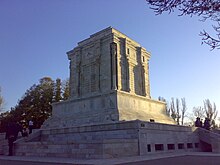
Iran's oldest literary tradition is that of Avestan, the Old Iranian sacred language of the Avesta, which consists of the legendary and religious texts of Zoroastrianism and the ancient Iranian religion, with its earliest records dating back to the pre-Achaemenid times.[452]
Of the various modern languages used in Iran, Persian, various dialects of which are spoken throughout the Iranian Plateau,[453][454] has the most influential literature. Persian has been dubbed as a worthy language to serve as a conduit for poetry, and is considered one of the four main bodies of world literature.[455] In spite of originating from the region of Persis (better known as Persia) in southwestern Iran, the Persian language was used and developed further through Persianate societies in Asia Minor, Central Asia, and South Asia, leaving massive influences on Ottoman and Mughal literatures, among others.
Iran has a number of famous medieval poets, most notably Rumi, Ferdowsi, Hafez, Saadi Shirazi, Omar Khayyam, and Nezami Ganjavi.[456] Iranian literature also inspired writers such as Johann Wolfgang von Goethe, Henry David Thoreau, and Ralph Waldo Emerson.[119][120][121]
Philosophy
Iranian philosophy originates from Indo-European roots, with Zoroaster's reforms having major influences.
According to The Oxford Dictionary of Philosophy, the chronology of the subject and science of philosophy starts with the Indo-Iranians, dating this event to 1500 BC. The Oxford dictionary also states, "Zarathushtra's philosophy entered to influence Western tradition through Judaism, and therefore on Middle Platonism."
While there are ancient relations between the Indian Vedas and the Iranian Avesta, the two main families of the Indo-Iranian philosophical traditions were characterized by fundamental differences, especially in their implications for the human being's position in society and their view of man's role in the universe.
The Cyrus Cylinder, which is known as "the first charter of human rights", is often seen as a reflection of the questions and thoughts expressed by Zoroaster, and developed in Zoroastrian schools of the Achaemenid era.[457][458] The earliest tenets of Zoroastrian schools are part of the extant scriptures of the Zoroastrian religion in Avestan. Among them are treatises such as the Zatspram, Shkand-gumanik Vizar, and Denkard, as well as older passages of the Avesta and the Gathas.[459]
Mythology
Iranian mythology consists of ancient Iranian folklore and stories, all involving extraordinary beings, reflecting attitudes towards the confrontation of good and evil, actions of the gods, and the exploits of heroes and fabulous creatures.
Myths play a crucial part in Iranian culture, and understanding of them is increased when they are considered within the context of actual events in Iranian history. The geography of Greater Iran, a vast area covering present-day Iran, the Caucasus, Anatolia, Mesopotamia and Central Asia, with its high mountain ranges, plays the main role in much of Iranian mythology.
Tenth-century Persian poet Ferdowsi's long epic poem Šāhnāme ("Book of Kings"), which is for the most part based on Xwadāynāmag, a Middle Persian compilation of the history of Iranian kings and heroes from mythical times down to the reign of Chosroes II,[460] is considered the national epic of Iran. It draws heavily on the stories and characters of the Zoroastrian tradition, from the texts of the Avesta, the Denkard, and the Bundahishn.
Music
Iran is the apparent birthplace of the earliest complex instruments, dating back to the third millennium BC.[461] The use of both vertical and horizontal angular harps have been documented at the sites Madaktu and Kul-e Farah, with the largest collection of Elamite instruments documented at Kul-e Farah. Multiple depictions of horizontal harps were also sculpted in Assyrian palaces, dating back between 865 and 650 BC.


Xenophon's Cyropaedia mentions a great number of singing women at the court of the Achaemenid Empire. Athenaeus of Naucratis, in his Deipnosophistae, points out to the capture of Achaemenid singing girls at the court of the last Achaemenid king Darius III (336–330 BC) by Macedonian general Parmenion. Under the Parthian Empire, the gōsān (Parthian for "minstrel") had a prominent role in the society.[462] According to Plutarch's Life of Crassus (32.3), they praised their national heroes and ridiculed their Roman rivals. Likewise, Strabo's Geographica reports that the Parthian youth were taught songs about "the deeds both of the gods and of the noblest men".[463]
The history of Sasanian music is better documented than the earlier periods, and is especially more evident in Avestan texts.[464] By the time of Chosroes II, the Sasanian royal court hosted a number of prominent musicians, namely Azad, Bamshad, Barbad, Nagisa, Ramtin, and Sarkash.
Iranian traditional musical instruments include string instruments such as chang (harp), qanun, santur, rud (oud, barbat), tar, dotar, setar, tanbur, and kamanche, wind instruments such as sorna (zurna, karna) and ney, and percussion instruments such as tompak, kus, daf (dayere), and naqare.
Iran's first symphony orchestra, the Tehran Symphony Orchestra, was founded by Qolam-Hoseyn Minbashian in 1933. It was reformed by Parviz Mahmoud in 1946, and is currently Iran's oldest and largest symphony orchestra. Later, by the late 1940s, Ruhollah Khaleqi founded the country's first national music society, and established the School of National Music in 1949.[465]
Iranian pop music has its origins in the Qajar era.[466] It was significantly developed since the 1950s, using indigenous instruments and forms accompanied by electric guitar and other imported characteristics. The emergence of genres such as rock in the 1960s and hip hop in the 2000s also resulted in major movements and influences in Iranian music.[467][468][469][470]
Theater
The earliest recorded representations of dancing figures within Iran were found in prehistoric sites such as Tepe Sialk and Tepe Mūsīān.[471] The oldest Iranian initiation of theater and the phenomena of acting can be traced in the ancient epic ceremonial theaters such as Sug-e Siāvuš ("mourning of Siāvaš"), as well as dances and theater narrations of Iranian mythological tales reported by Herodotus and Xenophon.
Iran's traditional theatrical genres include Baqqāl-bāzi ("grocer play", a form of slapstick comedy), Ruhowzi (or Taxt-howzi, comedy performed over a courtyard pool covered with boards), Siāh-bāzi (in which the central comedian appears in blackf


